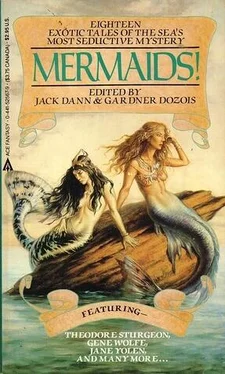Гарднер Дозуа - Mermaids!
Здесь есть возможность читать онлайн «Гарднер Дозуа - Mermaids!» весь текст электронной книги совершенно бесплатно (целиком полную версию без сокращений). В некоторых случаях можно слушать аудио, скачать через торрент в формате fb2 и присутствует краткое содержание. Год выпуска: 1986, ISBN: 1986, Издательство: Ace, Жанр: Фантастика и фэнтези, на английском языке. Описание произведения, (предисловие) а так же отзывы посетителей доступны на портале библиотеки ЛибКат.
- Название:Mermaids!
- Автор:
- Издательство:Ace
- Жанр:
- Год:1986
- ISBN:0-441-52567-9
- Рейтинг книги:5 / 5. Голосов: 1
-
Избранное:Добавить в избранное
- Отзывы:
-
Ваша оценка:
- 100
- 1
- 2
- 3
- 4
- 5
Mermaids!: краткое содержание, описание и аннотация
Предлагаем к чтению аннотацию, описание, краткое содержание или предисловие (зависит от того, что написал сам автор книги «Mermaids!»). Если вы не нашли необходимую информацию о книге — напишите в комментариях, мы постараемся отыскать её.
Mermaids! — читать онлайн бесплатно полную книгу (весь текст) целиком
Ниже представлен текст книги, разбитый по страницам. Система сохранения места последней прочитанной страницы, позволяет с удобством читать онлайн бесплатно книгу «Mermaids!», без необходимости каждый раз заново искать на чём Вы остановились. Поставьте закладку, и сможете в любой момент перейти на страницу, на которой закончили чтение.
Интервал:
Закладка:
But if, as for example E. M. Forster and many others say, the sirens were simply seals, then "what song the sirens sang" was merely the ooping and yerping which most of us, probably, have heard either along a sea-coast or in a circus, aquarium, or zoo. Interesting. Hardly romantic, though. But why was their song so deadly? I search in vain the accounts of the legends for a rational explanation, and perhaps I am wrong to do so: in more recent times we read that merpeople are sometimes the souls of the dead, particularly the drowned-dead: there is a reason: as you are now, so once was I; as I am now, so you must be: come into Drownlandia and join me.... But what may the reason have been in the beginning? I have a theory. Hearken on. Look at detailed maps of whatsoever waters of whatsoever countries which have coasts, and sooner or later you will see for certain, next to very small dots, the immemorial words, Seal Rocks . Not once and again, but again and again.
And again and again and again.
In other words, if as you sailed along uncharted waters and uncharted shores in those days before charts and were close enough to hear the seals, well, sonny, you were too close Much too close. And even as we accept that before the sirens were seals, or some sort of sea-creatures, they were bird-women, the principles of navigation remain the same: birds, seabirds, often frequent offshore rocks and inshore crags, rocky seacliffs; and if you are close enough to hear them "singing," say, you are too close: your vessel may strike those rocks. "And the angry rocks they gored her sides, like the horns of an angry bull." And then it will be a case of "Going down. My God. Going down!"
These are facts, and the rest is embroidery.
It is, or course, a fairly gorgeous embroidery.
This thought occurred to me: "Mermaid sightings were the UFO sightings of times past." However, I don't want to follow that thought to its logical confusion. However, I do want to give a partial listing of what I might term "major mermaid sightings" throughout a period of hundreds of years, because it might be useful. When I say "major mermaid sightings," really, I mean, those which were for one thing written down, and for another, were reported in the very good book Sea Enchantress: The Tale of the Mermaid and Her Kin , by Mr. Owen Benwell and Sir Arthur Waugh, and published by The Citadel Press, N.Y., in 1965. (The authors are described as "both prominent members of the British Folk-Lore Society—Sir Arthur has been its President—and have devoted several years to collecting mer-legends of all times and places." I don't know if Sir Arthur is any relation to Evelyn Waugh, whose father was also named Arthur, but who was not a knight and who died many years ago.) I have collected these sightings out of the book and arranged them for this Adventure and sometimes abbreviated the language of the book. And, following these listings, I shall list others. Surely you will all see why.
Some time in the first half century of the Christian Era, Pliny the Elder cites as his "authors," i.e. authorities, "divers knights of Rome, right worshipfull persons and of good crédite, who testifie that in the coast of the Spanish Ocean neere unto Gades [Cadiz], they have scene a Mereman, in every respect resembling a man in all parts of the bodie as might bee."— This last sounds ambiguous; but such is the report.
Here's one from an old Irish, that is, Gaelic, MS: "In the year 558 was taken the Mermaid, i.e. Liban, the daughter of Eochaidh, the son of Murieadh, on the strand of Ollarbha, in the net of Beoan, son of Inli, the fisherman of Comhgall of Beannchair."—The fact that the geneology of the mermaid is known so nicely, is here passed by without comment.
Another from the Irish. In the years 887 "a mermaid was cast ashore by the sea in the country of Alba... she was whiter than the swan all over."
The year 1018: "Another wonderful tale from Ireland: a mermaid was taken by the fisherman of the Weir of Lisarglinn in Ossory, and another at Port-Lairge."
Year 1147: Knights going to the Second Crusade were in the Bay of Biscay, "'annoyed' by sirens, 'who made a horrible noise of wailing, laughing and jeering, like the clamour of insolent men in a camp.' ... it is recorded that the Crusaders became penitent."
The 12th century, that is, the same as the previous two: "A monster was seen near Greenland... 'approximated' in all respects to a human being down to the waist, thereafter she resembled a fish. The hands seem... to be long, and the fingers ... united like a web like that on the feet of water-birds
This in turn reminds us of the story that Charlemagne's grandmother had webbed feet, la reine pedauque ; she was sometimes called Big-footed Bertha. Some say only that she had hairy feet. The consensus must be, she had funny feet. It is true that sometimes babies are born with some sort of webbing between two of more toes, this may be merely ontology recapitulating ichthyology, or whatever; it may be the origin of a fairly common tradition in many places that certain human families are descended from mermaids.
The year 1197: "... at Oreford in Suffolk... a fish was taken by fishers in their nets... resembling in shape a wild or savage man..." Nothing is said in the description, which is very detailed, of his having a fish-tail. He did eat fish both raw and cooked and he "would not or could not utter any speech." Eventually he escaped back to sea. A logical explanation might be simply that he was either a mute, or a nut who liked to swim a whole hell of a lot: but: he was caught in fishnets, therefore he was a fish. Figures ... don't it... in a way? "All fish swim, Fred swims, therefore Fred is a fish."
The year 1403. The scene Holland. The event a great storm. Alas, no brave little Dutch boy was around to stick his finger into the leak in the dike, and the dikes broke and flooded "the vicinity of Edam," where the cheese comes from. "A mermaid floated in" but could not float out, and was taken up by kindly Dutch homemakers who fed her and clothed her and taught her to spin and to "kneel down... before the crucifix, she never spake, but lived dumbe and continued alive... fifteen years; then she died."—It may be that all strange mutes found near water were retroactively legendized into mer-folk. Eh? And worse things could have happened to them, considering.
1523: " 'the third day of November, there was seen at Rome this sea-monster, the bignesse of a child of five yeeres old, like to a man even to the navell, except the ears; in the other parts it resembled a fish.'"—the source here is a famous and respected Ambrose Paré, the Surgeon-General of France, and a pioneer in treating wounds and wounded.
1550. Orefund, Denmark: A creature taken from the sea was brought, either dying or already dead, to the king, and "its head 'resembled that of a human creature with cropped hair.. .' "—This differs from the usual traditional description of very long hair.
1560. "The report of the netting, in one draught, of seven mermen and mermaids off the coast of Mandar, Ceylon... must have carried conviction to those who heard it, supported as it was by the testimony of several Jesuits and by one Bosquez, physician to the Viceroy of Goa. Bosquez, his professional instincts thoroughly aroused, dissected the seven luckless sea-creatures. His report (which was taken seriously enough to be included in the Histoire de la Compagnie de Jesus , No. 276) stated that, both externally and internally, the mermen and mermaids were exactly similar to human beings."—Can it be that they were human beings? What, then, made them sea-creatures? Answer: They were found in the sea.
About the same date: "... a work by the French historian and traveller, André Thevet [mentions]... sea-monsters in human shape ... seen off the coast of Africa... 'that the floud had left on the shore, the which was heard to cry. In like case the female came with the next floud, crying aloud and sorrowing . . . By this may be knowen, that the Sea doeth nourishe and bring forth divers, and strange kind of monsters, as well as the land. ' "—To which one may only reply, indeed it doeth.
Читать дальшеИнтервал:
Закладка:
Похожие книги на «Mermaids!»
Представляем Вашему вниманию похожие книги на «Mermaids!» списком для выбора. Мы отобрали схожую по названию и смыслу литературу в надежде предоставить читателям больше вариантов отыскать новые, интересные, ещё непрочитанные произведения.
Обсуждение, отзывы о книге «Mermaids!» и просто собственные мнения читателей. Оставьте ваши комментарии, напишите, что Вы думаете о произведении, его смысле или главных героях. Укажите что конкретно понравилось, а что нет, и почему Вы так считаете.











![Гарднер Дозуа - Книга Мечей (сборник) [litres с оптимизированной обложкой]](/books/427839/gardner-dozua-kniga-mechej-sbornik-litres-s-opti-thumb.webp)